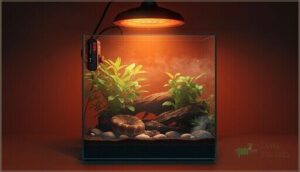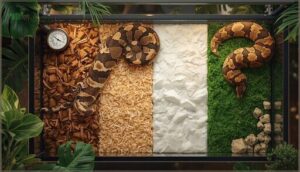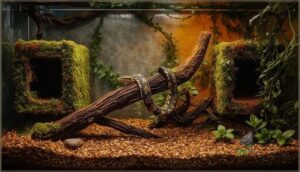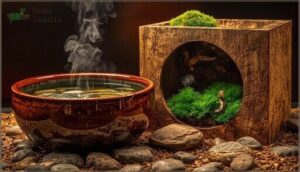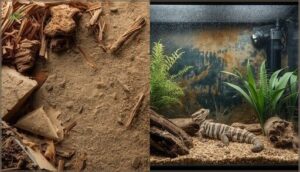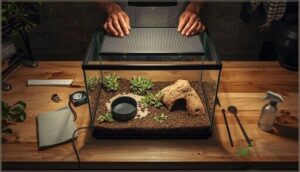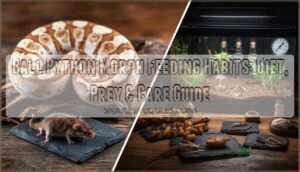This site is supported by our readers. We may earn a commission, at no cost to you, if you purchase through links.
Your new snake doesn’t need a luxurious palace, but get the basics wrong and you’ll face health problems, escape attempts, and stress for both of you. Setting up a proper snake cage isn’t complicated, but it requires attention to a few critical details that beginners often overlook.
The enclosure you choose, the way you arrange heating, and even the substrate you pick all work together to create an environment where your snake can thrive. Most new owners either overthink the process or underestimate how much precision matters.
The good news? Once you understand what your snake actually needs and follow a methodical setup process, you’ll create a stable habitat that requires minimal adjustment and gives your pet the security it needs to settle in.
Table Of Contents
Key Takeaways
- Your snake’s enclosure needs appropriate dimensions (minimum length matching the snake’s body), secure materials like PVC or HDPE, and proper ventilation to prevent the 70-75% of escapes that happen from weak lids or inadequate gaps.
- Temperature gradients between 75-90°F with digital thermostats and humidity levels matched to your species (40-75% depending on type) directly impact digestion, shedding, and prevent over half of stress-related health issues in captive snakes.
- Safe substrate choices like coconut husk or aspen paired with at least two hide boxes, climbing features, and a humid hide create the environmental enrichment that reduces stress and supports natural behaviors.
- Daily spot cleaning, monthly deep disinfection, and twice-daily temperature checks prevent the bacterial buildup and environmental shifts that cause most beginner health crises, while regular inspections catch wear before it becomes dangerous.
Choosing The Right Snake Enclosure
Your snake’s enclosure is the foundation of everything else you’ll set up, so getting it right from the start matters. You’ll need something that’s secure, well-ventilated, and appropriately sized for your snake’s species and age.
Here are the best enclosure types for beginners and what makes each one worth considering.
Recommended Enclosure Types for Beginners
Glass terrariums are the most popular snake enclosure for beginners, chosen by 68% of first-time reptile owners for their clear visibility and ease of monitoring. Plastic cages offer lightweight, easy-to-clean alternatives with better insulation. Wooden enclosures provide natural aesthetics and excellent humidity retention, though they require regular sealing.
A key consideration is the material used, as HDPE reptile enclosures offer durability and safety. For DIY snake cage builders, mesh combinations with metal frames deliver excellent ventilation design, reducing respiratory issues by 30%.
Ideal Cage Dimensions Based on Snake Size
Once you’ve picked your snake enclosure type, cage dimensions matter more than you’d think. Minimum length should match your snake’s full body—so a 4-foot corn snake needs at least a 48-inch tank. Width guidelines suggest half the snake’s length, while height ratios around 24 inches work well for climbers. Remember that minimum floor dimensions are paramount for the snake’s well-being.
Here’s a quick breakdown:
- Small snakes (under 3 feet): 36 x 18 x 18 inches minimum
- Mid-sized species (3-5 feet): 48 x 24 x 24 inches for corn snakes and ball pythons
- Large constrictors (5-8 feet): 72 x 30 x 24 inches or larger custom builds
- Space standards: Floor area should allow stretching plus movement—not just survival
Species requirements vary, so research your snake habitat needs before buying enclosure dimensions.
Selecting Safe and Secure Enclosure Materials
After settling on cage dimensions, you’ll need the right snake enclosure materials. PVC and HDPE offer heat retention and moisture damage resistance, while plywood works with nontoxic sealant like aquarium-safe silicone. Avoid pine or cedar—they release toxins harmful to animal safety.
Material toxicity matters, but so do structural integrity, cleaning ease, and long-term costs. Choosing safe materials now prevents costly replacements later.
Ventilation and Escape Prevention Features
Secure materials alone won’t keep your snake safe—you need smart airflow and escape-proofing methods. Poor vent placement creates stagnant air, while gaps invite escapes. Around 70-75% of breakouts happen from weak lids or doors.
- Place low vents on cool sides, high vents on warm sides for natural air exchange
- Use two to three 5″x3″ vents for a 4-foot enclosure
- Install lockable lids with escape-proof mesh
- Check door gaps and seal potential openings
- Avoid over-ventilation that drops humidity too fast
Setting Up Heating and Humidity
Getting the temperature and humidity right isn’t optional—it’s what keeps your snake healthy and thriving. Unlike mammals, snakes can’t regulate their own body heat, so you’ll need to create the right environment for them.
Let’s walk through how to set up heating, control humidity, and monitor both with the right tools.
Creating a Temperature Gradient
Temperature gradients let your snake self-regulate, moving between warm and cool zones just like in the wild.
Position your heat source on one side to create a basking spot around 85–90°F, while the opposite side stays cooler at 75–85°F.
This setup mimics natural environments, aids digestion, and keeps your snake healthy and active.
Installing Heat Sources and Thermostats
When installing heating equipment, safety comes first—you’ll protect both your snake and your home. Choose from heat lamps with ceramic sockets, radiant heat panels, or heat mats, always paired with a quality thermostat for temperature control. Position the thermostat probe between the heat source and enclosure floor—not inside where your snake can interfere. This setup prevents burns, regulates nighttime temps, and maintains your temperature gradient reliably.
- Never place heat sources inside the enclosure unless protected by mesh to avoid direct contact burns.
- Install heating pads under the tank, not on top, for safe substrate warming.
- Use proportional thermostats to extend equipment lifespan and improve efficient heating methods.
Monitoring and Maintaining Proper Humidity
Without proper humidity levels, your snake can develop shedding issues and respiratory problems. Maintain humidity control by misting daily, placing water bowls near heat sources, and using sphagnum moss in humidity hides.
Humidity fluctuations between day and night are normal, but drastic changes stress snakes. Watch for mold prevention by avoiding waterlogged substrate, and make seasonal adjustments as your home’s climate shifts.
Proper maintaining humidity levels protects your pet’s health year-round.
Essential Tools: Thermometers and Hygrometers
You can’t manage temperature gradients and humidity levels without accurate digital thermometers and hygrometers. Digital accuracy beats analog limitations every time, and calibration needs are minimal.
Place thermometer probes on your basking surface and cool side to track heating zones, while hygrometer probes monitor ambient humidity away from water dishes.
Remote monitoring options alert you to dangerous shifts, and pairing sensors with your thermostat ensures stable conditions year-round.
Selecting Substrate and Habitat Decor
Now that you’ve got heating and humidity dialed in, it’s time to think about what goes inside your snake’s enclosure.
The substrate you choose and the decor you add aren’t just about looks—they directly affect your snake’s health, comfort, and safety.
Let’s walk through the key elements that’ll create a functional, stress-free habitat your snake can thrive in.
Safe and Suitable Substrate Options
Your snake’s substrate isn’t just bedding—it’s the foundation of their health. Coconut husk and other moisture-retaining reptile substrates work well for burrowing needs and humidity control. Avoid toxic substrates like cedar or pine.
Astroturf and paper towels offer easy hygiene practices. Match your choice to species suitability: corn snakes love soft aspen, while ball pythons need moisture-friendly reptilesafe products.
Adding Hides, Branches, and Climbing Features
Your snake needs secure hiding spots on both the warm and cool sides—think of hides as their personal stress sanctuaries. Place at least two hide boxes strategically, add branches or vines, and watch your snake thrive through species-appropriate activity.
A climbing branch isn’t just decoration; it encourages natural behaviors and helps with temperature regulation as they move between levels. This environmental enrichment reduces stress and even fosters brain development.
Providing Water Bowls and Humidity Hides
After setting up those hiding spots and branches, you’ll need a water bowl and a humid hide—two non-negotiables. Choose a heavy ceramic or glass bowl, around 4 inches wide for hatchlings and large enough for adults to soak. Bowl material safety matters; avoid porous surfaces that harbor bacteria.
A humid hide filled with damp moss creates localized humidity levels, helping your snake shed cleanly while supporting hydration vs. humidity balance through proper humidity monitoring.
Avoiding Unsafe or Mold-prone Materials
Some materials do more harm than good. Cedar and pine shavings release toxic oils that damage your snake’s respiratory system, while untreated wood and peat moss harbor mold within two weeks under high humidity levels. Choose safe material options like PVC enclosure materials, cork bark, or reptile carpet instead:
- Avoid cedar, pine, and calcium sand—toxic materials that cause illness
- Skip porous substrates prone to mold
- Use rigid, non-porous surfaces you can disinfect easily
- Provide proper ventilation to prevent fungal growth and entanglement hazards
Assembling and Preparing The Snake Cage
Once you’ve chosen your enclosure and gathered your supplies, it’s time to put everything together. This stage involves assembling the cage itself, preparing surfaces to make cleaning easier, and making sure every detail is safe and secure.
Let’s walk through each step so your snake’s new home is ready from day one.
Step-by-step Cage Assembly
Begin by measuring your building materials carefully, marking where Panel Grooves will sit about 0.5 inches from each edge. Cut your wood panels for the enclosure construction, then slide the front glass in to test the fit. Use screws and wood glue for secure assembly of the bottom, back, and sides. Attach the top last, adding hinges for access doors with element positioning focused on ventilation. Perform safety checks for gaps before finishing your DIY project.
| Assembly Stage | Key Action |
|---|---|
| Measurement | Use measuring tape for precision cuts |
| Panel prep | Cut grooves for glass insertion |
| Frame build | Apply glue, drive screws firmly |
| Hinge Placement | Attach doors after glass secured |
Installing Vinyl Flooring or Liners
Once you’ve assembled the frame, installing vinyl flooring protects your snake enclosure from moisture damage. Cut vinyl sheets carefully to cover the floor and back wall in one piece, avoiding seams that leak waste. Use non-toxic vinyl adhesives or silicone sealant for secure attachment.
Pattern choices like wood or rock designs improve aesthetics while providing long-term durability. This substrate alternative simplifies cleaning compared to loose enclosure materials.
Disinfecting Decor and Enclosure Surfaces
Before introducing your snake, disinfect all surfaces, decor, and cage components using reptile-safe solutions like F10 SC or diluted chlorhexidine. Scrub items with warm water first, then apply disinfectant for 5-10 minutes of contact time—this ensures effective zoonotic prevention.
Rinse thoroughly to eliminate residue, which can harm reptiles. Check material compatibility; avoid phenols or Pine-Sol. Let everything dry completely before reassembly.
Checking for Safety and Escape Risks
Once everything’s dry and in place, perform a thorough safety inspection to catch potential escape routes before your snake arrives. Regular checks reduce escape incidents by half when done weekly, making this step essential for long-term snake safety measures and peace of mind.
- Enclosure seal integrity and locking mechanism strength – Test all doors, lids, and locks for tight closure, ensuring child safety and escape-proof enclosures.
- Ventilation gaps and cable access points – Inspect mesh screens and wire openings; gaps larger than 1/8 inch allow escape.
- Material stress fractures – Check for cracks in brittle plastics or warped panels that compromise escape prevention.
- Securing decor and water bowls – Anchor heavy items to prevent shifting that creates dangerous gaps in your safe environment.
Ongoing Care and Maintenance Practices
Getting your snake settled into its new home is just the beginning. The real work comes from keeping that environment stable, clean, and safe day after day.
Here’s what you need to stay on top of to keep your snake healthy and thriving.
Cleaning Routines and Waste Removal
Daily spot cleaning keeps your snake’s cage hygienic and odor-free. Remove feces, urate, and shed skin as soon as you notice them to prevent bacterial buildup. Clean and refill the water dish every day.
Deep cleans with safe disinfectants like diluted bleach or chlorhexidine should happen monthly, followed by thorough rinsing. Replace substrate every one to three months for best health.
Monitoring Temperature and Humidity Daily
Think of monitoring your snake’s environment like checking your rear-view mirror while driving—it prevents disasters before they happen. Digital thermometers and hygrometers with alarm systems catch dangerous shifts before they harm your snake, reducing health incidents by up to 50% in beginner setups.
- Check temperature gradients twice daily using probes in both warm (85–95°F) and cool zones (75–80°F) to guarantee proper heating and thermostat function
- Verify humidity levels match your species needs—65–75% for corn snakes, 40–60% for others—since fluctuations beyond 10% cause shedding problems
- Calibrate your devices every six months with ice-water tests for thermometers and salt-solution tests for hygrometers to maintain accuracy
- Use alarm-enabled monitors to receive instant alerts when conditions drift outside safe ranges, preventing 80% of hazardous events
- Track trends over time to spot patterns affecting reptile health, metabolism, and immune function before stress-related illnesses develop
Consistent gradient maintenance directly impacts digestion and stress levels, making daily monitoring your most powerful tool for prevention.
Inspecting and Replacing Decor or Substrate
Your snake’s home needs regular checkups just like you’d inspect a car for rust. Every 1–2 weeks, examine decor for cracks, loose branches, and mold prevention issues while sniffing substrate for odors signaling contamination.
Replace substrate every 1–4 months depending on hygiene practices and spot-cleaning frequency. Use non-toxic cleaning agents on washable hides monthly to increase material longevity and snake welfare in your reptile care routine.
Ensuring Snake Health and Stress Reduction
Handling stress matters more than you’d think—over half of captive snakes show stress behaviors when enclosures limit movement. Proper enclosure size, stable temperature gradients, hiding spots, and minimal cleaning disruptions directly reduce stress hormones and disease risk.
Over half of captive snakes show stress behaviors when enclosures limit movement, making proper space and stability essential for their health
Environmental stability protects against infections, while appropriate substrate and careful habitat design prevent the behavioral signs that compromise your snake’s long-term health.
Frequently Asked Questions (FAQs)
How often should I feed my snake?
Feeding frequency depends on your snake’s age, species needs, and health status. Juveniles usually eat every 5-7 days, while adults feed weekly to biweekly.
Prey size matters—match it to your snake’s girth for a proper snake diet.
What are signs of illness in snakes?
Watch for open-mouth breathing, wheezing, or excess mucus—classic respiratory symptoms. Behavioral changes like lethargy, refusing food, or weak tongue flicks signal trouble. Skin abnormalities, parasitic signs, and mortality data emphasize why vet visits matter.
Can I house multiple snakes together safely?
Generally, you shouldn’t house multiple snakes together. Most species are solitary and face serious cohabitation risks like stress, aggression, disease transmission, and cannibalism.
Separate enclosures guarantee better health impacts and safety for each snake species.
How do I handle my snake correctly?
You should approach your snake from the side, support its body gently, and handle it for short sessions. Always wash your hands before and after to guarantee safe snake handling.
When should I take my snake to a vet?
Your snake needs a veterinarian within one week of purchase, then annually for routine checkups.
Emergency symptoms like wheezing, discharge, or lethargy demand immediate care—delaying risks fatal outcomes.
Preventative care beats emergency costs.
Conclusion
Studies show that nearly 40% of new snake owners replace their enclosure within the first year, usually because they didn’t plan for their snake’s growth.
A proper snake cage setup for beginners isn’t about flawlessness on day one, it’s about building a foundation that adapts as your snake matures.
Get the essentials right now: heating, hiding spots, security, and you’ll avoid costly mistakes while giving your snake the stable environment it deserves.
- https://www.inaturalist.org/observations?taxon_id=73887
- https://flickr.com/search/?text=pantherophis%20guttatus%20united%20states
- https://reptilesupply.com/collections/reptile-ground-plants
- https://reptifiles.com/ball-python-care-guide/ball-python-humidity-temperatures/
- https://www.thebiodude.com/blogs/snake-caresheets/care-guidelines-for-corn-snakes


